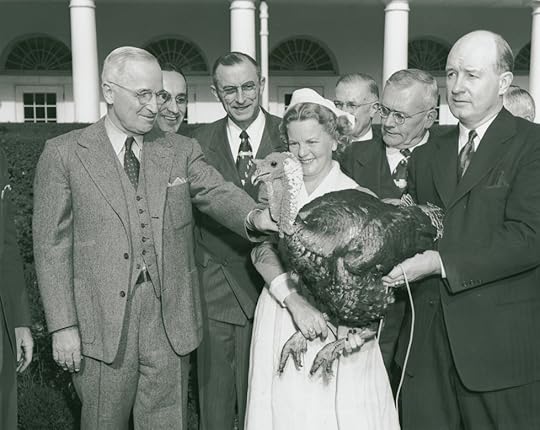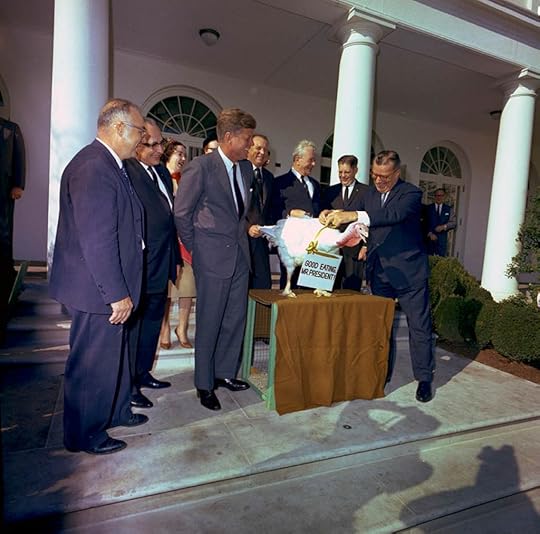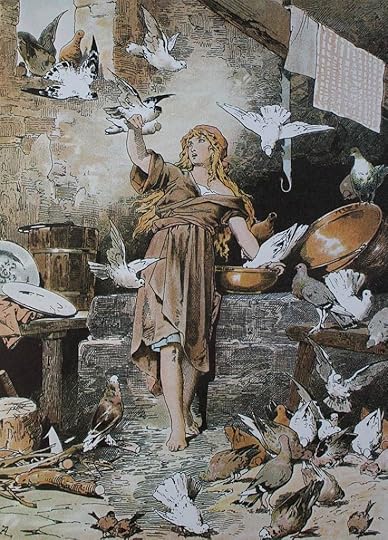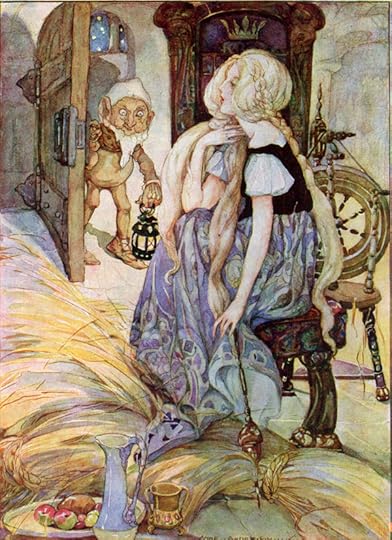Ripley Entertainment Inc.'s Blog, page 172
November 23, 2020
The First Thanksgiving Feast Featured Shellfish, Swan, And No Women
Featured in Ripley's Believe It or Not!

Imagine you’re getting ready to sit down for your annual Thanksgiving dinner. The harmonious aroma of turkey, potatoes, and cranberry sauce is wafting through the house. You’ve likely fasted all day to ensure you have enough stomach room for a heaping plate of it all. (Perhaps, you even wore your special stretchy pants.)
Instead of sitting down for this once-a-year Thanksgiving feast, picture your family’s table dressed with a spread of venison, swan, and shellfish. Not exactly screaming, “Thanksgiving dinner.” In this case, you’d be eating exactly what the Pilgrims and the Wampanoag Indians prepared for the very first Thanksgiving!
While the gathering could have served the traditional turkey and corn pairing, it’s just as likely that the feast included a different bird—possibly swan—in addition to venison and shellfish, historians say. The corn was probably a bit off-menu too, as it could have been mashed up and used as a type of porridge.
New England Today magazine reprinted a letter that Edward Winslow, an English teacher at the time, wrote home to a friend, where he described the day like this:
“[F]or three days we entertained and feasted, and they went out and killed five deer, which we brought to the plantation and bestowed on our governor, and upon the captain and others. And although it be not always so plentiful as it was at this time with us, yet by the goodness of God, we are so far from want that we often wish you partakers of our plenty.”

“The First Thanksgiving at Plymouth” (1914) By Jennie A. Brownscombe
So, it’s clear that this first gathering had quite a bit of food. But, was their deer dish accompanied by one of the Thanksgiving staples: cranberry sauce? While the pilgrims probably knew about the fruit, the lack of available sugar would have prevented them from turning it into a sauce. Historians say it would be another 50 years before anyone did that.
Most of the food present on their table was actually shellfish. After all, they were feasting in New England! Where else can you get the best lobster, oysters, and clams? All were probably on the table, in addition to mussels and even eels!
Perhaps the most perfect pair alongside turkey, stuffing, and cranberry sauce is the beloved potato—mashed, sweet, baked, you name it! Unfortunately, none of the above were present for the first feast. Potatoes weren’t popular enough yet to make their way to the table, but turnips could’ve been. Then again, we’re not sure anyone ever got too excited about homemade mashed turnips.
So, what about dessert? What about pumpkin pie? Well, there was no butter or wheat flour for the crust, and of course, no ovens for baking. The closest anyone got to pumpkin pie were hollowed-out pumpkins, filled with milk and honey, and roasted. Certainly tasty, but it’s no pumpkin pie.

Thanksgiving in Camp, a wood engraving drawn by Winslow Homer and published in Harper’s Weekly, November 29, 1862.
Aside from the food on the table, what’s the biggest difference between today’s Thanksgiving dinner and those of yesteryear? No women.
Winslow reported that 90 men attended the feast, and NPR interprets this fact to mean no women were allowed. Those present viewed the dinner as a political meeting, not as the family get-together we celebrate today. And that meant the women stayed home.
“The Wampanoags and the Pilgrims were cementing a military alliance,” Robert Krulwich of NPR, wrote. “Massoasoit, the Wampanoag king, was there. So was the English governor, William Bradford. The first Thanksgiving was mostly a guys-only event where the English women, says [writer Andrew] Beahrs ‘were likely doing the bulk of the cooking.’”
There you have it. Not the food you expected. Not the company you expected.
It’s inarguable the Thanksgiving food—and the company—have just gotten better over time.
By Ryan Clark, contributor for Ripleys.com and host of Ripley’s Believe It or Notcast
EXPLORE THE ODD IN PERSON!
Discover hundreds of strange and unusual artifacts and get hands-on with unbelievable interactives when you visit a Ripley’s Odditorium!
Source: The First Thanksgiving Feast Featured Shellfish, Swan, And No Women
CARTOON 11-23-2020
November 22, 2020
CARTOON 11-22-2020
November 21, 2020
CARTOON 11-21-2020
November 20, 2020
Thanksgiving Dinner With Rebecca The Holiday Raccoon
Featured in Ripley's Believe It or Not!

The holiday season is upon us, and there’s no better way to spend it than with family, friends, and of course, our pets! If there’s one thing we all have in common, it’s the love for our four-legged, two-legged, tailed, and scaled family members. And, Believe It or Not!, the White House residents aren’t much different when it comes to celebrating the holidays with their non-human inhabitants. From the Reagans to the Kennedys, let’s gobble up some of the most bizarre animal pardons to hit the Thanksgiving table.
Ruffling Feathers
The annual practice of pardoning a turkey at Thanksgiving has become quite a quirky tradition at the White House, but how did it get started and why? Back in the 1870s, poultry dealer Horace Vose began supplying well-fed turkeys to the White House, not as pets, but as the main course on the family’s Thanksgiving Day menu. Contrary to what we see today, there hasn’t always been a peace pact between president and poultry.
Unofficially, good ole Honest Abe is said to have started the tradition of keeping the gobbling main dish off the table and onto the family tree. Abe “pardoned” a turkey back in 1863 when his son, Tad, grew particularly fond of the bird, naming their newest companion, Jack. At the request of his child, Abe spared the bird that Thanksgiving and some of his successors seemed to follow his lead.
You may have heard that President Harry Truman was the father of the presidential turkey pardon—but this is, unfortunately, false. Photos from Truman’s administration show the President happily receiving a turkey as a gift from the Poultry and Egg National Board at a public event. But, the archivists at the Harry S. Truman Presidential Library and Museum in Independence, Missouri, have tried to set the record straight. On the museum’s website, it states “The Library’s staff has found no documents, speeches, newspaper clippings, photographs, or other contemporary records in our holdings which refer to Truman pardoning a turkey that he received as a gift in 1947, or at any other time during his Presidency.”

President Harry Truman with a turkey, presented to him by the Poultry and Egg National Board, in the White House Rose Garden on November 16, 1949.
Harry S. Truman Presidential Library/NARA
The photo in question was of Truman receiving a turkey, kicking off an annual tradition of presidents receiving turkeys from the National Turkey Federation. But, let’s not throw Truman under the bus all by himself. Presidents Eisenhower, Ford, Nixon, and Carter were all guilty of “dressing the turkeys for dinner,” as well. And we’re not talking about tuxedos. So, if all of these Presidents chowed down on their table additions, where does the tradition of pardoning a Thanksgiving turkey come from?
Pardon My Turkey
Just days before his assassination, President John F. Kennedy casually spared his turkey. When given the bird, it wore a sign reading, “Good Eating Mr. President,” and rather than carve up the fowl, Kennedy said, “Let’s just keep him.” And, in 1987, President Reagan sent his winged-gift, named Charlie, off to a petting zoo. Though again, neither were an official pardon, they are credited in many present-day stories as a root of the tradition.

Photo via John F. Kennedy Presidential Library and Museum/NARA
It wasn’t until 1989, the year of George H. W. Bush’s first Thanksgiving that the bird was officially pardoned. There’s no concrete reason why President Bush put pen to paper and started this tradition, but those turkeys had it made. Aptly named May and Flower, the two birds were not only spared by President Bush, but received the royal treatment. Post-ceremony, May and Flower were flown to Disney World where they served as honorary grand marshals in Disney’s Thanksgiving Day Parade. President Bush wished them luck on their journey stating, “May they live the rest of their lives in blissful gobbling.”
A Traditional Thanksgiving Raccoon
With turkeys off the table, it may seem as though the story ends here. But amidst all the gobbling gifts to arrive at the front door of the White House, turkeys weren’t the only animals who needed saving. In late November 1926, a man named Vinnie Joyce from Mississippi sent President Calvin Coolidge a different animal to grace his Thanksgiving table—a raccoon.

Grace Coolidge and Rebecca the Raccoon
Raccoons are supposedly full of meat less fatty than that of the more commonly consumed opossum. But even so, Coolidge had never tasted raccoon meat—and he wasn’t about to start with a gift from the forests of Mississippi. When asked if the raccoon was edible, the president said it might be for some people, but not for him.
Instead of carving the bandit-eyed critter, President Coolidge and his family decided to adopt the raccoon as a presidential pet. The Coolidge family was no stranger to housing unusual animals; they were also the proud owners of a black-haired bear, an African pygmy hippopotamus, and even a pair of lion cubs. The press called their home the “Pennsylvania Avenue Zoo.”
A Trash Panda in the White House
You would think, alongside lions and bears, a raccoon would be the least of the family’s worries. But according to the White House Staff, Rebecca was a “regular Houdini.” She could wriggle free from harnesses, break out of her cages, and she tore apart just about everything in the house from clothing to furniture—sounds more like the scavenging raccoons we know today.
Eventually, the Coolidge family built Rebecca a wooden house on the White House’s South Lawn, just outside the window of the President’s office. It actually wasn’t until Christmas that year that Rebecca received her name, along with a shiny collar engraved with her title: Rebecca Raccoon of the White House.
So, what happened to this woodland critter, you might ask? Eventually, after some more temper tantrums, outbreaks, and the supposed biting of President Coolidge, Rebecca retired from the press and paparazzi to the White House backyard. Coolidge actually granted her a companion, named Reuben, in 1928 to keep her company. But still, she wasn’t satisfied with her living arrangements and made many attempts to escape. When these fleeing habits became more and more common, the Coolidges decided to donate Rebecca to the National Zoo.
While we can expect to see more turkey pardons at the White House, we wouldn’t count on any of Rebecca’s cousins joining the crew anytime soon. It’s now illegal to keep a raccoon as a pet in the District of Columbia—and with the havoc Rebecca wreaked on the President’s closet, home, and living room, we can see why.
EXPLORE THE ODD IN PERSON!
Discover hundreds of strange and unusual artifacts and get hands-on with unbelievable interactives when you visit a Ripley’s Odditorium!
Source: Thanksgiving Dinner With Rebecca The Holiday Raccoon
Mount Rainier Hiker Gets Some R&R: Rescue And Resurrection
Featured in Ripley's Believe It or Not!

[November 16-November 22, 2020] A sci-fi worthy escape, the discovery of a mystery soldier, and Baby Yoda taking flight—all round-up in this week’s weird news from Ripley’s Believe It or Not!
Heron Foiled by Its Food
This week, 58-year-old amateur photographer Sam Davis of Maryland shared an image depicting something that seems more sci-fi than natural—a snake eel bursting through the stomach of a Heron, flying midair!
Though he took the picture in 2011, Davis decided to share it on Live Science this week. First believing the eel had latched itself to the bird’s neck, Davis soon realized it was actually coming straight out of the Heron’s stomach! The eel used it’s pointy tail to dig its way out of the Heron’s insides.
While it would seem that the Heron would immediately regret its choice in prey, Davis says it “didn’t seem to act much differently. It was in the water and flying around.”
Snake Eel bursts through Great Blue Heron’s throat. So many questions! https://t.co/ZJjh0YbF6G
— Ruth Foster (@SalmonRuth) November 12, 2020
Mystery Soldier Discovered in Lithuanian Lake
After over 500 years at the bottom of a Lithuanian Lake, the remains of a medieval soldier have been discovered.
The 16th-century soldier’s skeleton was found lying under a layer of mud during an underwater inspection of the Dubingiai Bridge in Lake Asveja in eastern Lithuania. There is no evidence that the body was part of a burial ceremony, but weapons recovered nearby indicate military status.
Along with the skeleton, the divers discovered a pair of leather boots, a leather belt with a buckle, an iron sword, and two knives. These items are being sent to the National Museum of Lithuania, where a team of archaeologists, anthropologists, and historians will study them and help craft the mystery soldier’s story.
The soldier is assumed to be linked with the Dubingiai Castle, which sat on Asveja Lake’s hillside.
Medieval soldier found with sword and knives at the bottom of a Lithuanian lake https://t.co/G5CdcESwvB pic.twitter.com/CzU4OmuOgW
— Live Science (@LiveScience) November 18, 2020
Mission Control, This is Baby Yoda
On Sunday, four astronauts blasted off in SpaceX, heading for the International Space Station, making history as the first commercially developed Crew Dragon capsule to take a full flight. But they weren’t alone. The Crew-1 astronauts made sure to bring a familiar face along for the ride—a plush Baby Yoda.
After launching from Kennedy Space Center in Cape Canaveral, Florida, the breakout star of Disney+’s “The Mandalorian” spent the 27-hour flight floating around the spaceship, on which he served as the mission’s zero-gravity indication. Upon arrival, he joined astronauts Mike Hopkins, Victor Glover, Shannon Walker, and current ISS residents in celebrating the historic journey. SpaceX is the first privately owned and operated aircraft certified by NASA for human flight.
“When you see him, it’s hard not to smile,” said Commander Michael Hopiks of the video of Baby Yoda bopping through the spacecraft.
The plush joins a long line of toys that have been used to identify when a spacecraft has entered lower gravity.
Baby Yoda arrives with four astronauts on board the @Space_Station as they begin a six month mission https://t.co/UDoANePjLa
CARTOON 11-20-2020
November 19, 2020
CARTOON 11-19-2020
November 18, 2020
Unfit For A Princess: The Grimm Fairy Tales
Featured in Ripley's Believe It or Not!

From Rapunzel to Rumplestiltskin, children hear many of these fairy tales every day. While you’re probably used to sharing some of these famous stories with your kids, their original iterations are certainly far beyond G-ratings.
A quick history if you need a refresher: The Grimm brothers were a couple of German storytellers who, in the early 1800s, first published all of their childhood stories into a popular volume. But, the stories weren’t originally meant for kids; these were some adult-themed fairy tales.
Here are four of the world’s most famous fairy tales—the way they were originally, terribly told.
Cinderella
The Grimms’ version of this famous tale is pretty gory. While it’s true that Cinderella does have an evil stepmother and two truly wicked stepsisters, the major difference here is the fairy godmother. In the Grimm version, she’s a magical tree with little dove minions to help her out. They come in handy when, at the end of the tale, the sisters are punished for being awful to Cinderella and making her do all those wretched chores. What do the birds do? They track down the stepsisters and peck out their eyeballs, leaving them as beggars on the street.

Alexander Zick illustrated Cinderella with the doves, inspired by the Grimms’ version.
Rapunzel
Another similar tale to our present-day recollection, Rapunzel has beautiful, long, golden hair. She’s trapped at the top of a tower by her witch of a mother (no really, she’s an actual witch). She is visited by a handsome prince who gets a bit R-rated with Rapunzel and soon a baby is on the way. Rapunzel’s mother finds out, chops off Rapunzel’s hair, and tosses the prince out the window.
Get ready for the gore…
When the Prince hits the ground, his eyeballs roll out of his sockets (nice detail, eh?) and poor Rapunzel is sent off with her children to live as a beggar.
So, what’s the moral of this story? Abstinence? Making sure to get regular haircuts? In another version of the tale, Rapunzel and the blind prince live happily ever after with their brood. That makes us feel just a little better.
Rumpelstiltskin
A poor miller tells his King a lie: that his daughter can spin straw into gold. So the king locks her up and tells her to follow through on the promise. A mischievous little imp then visits her and they make a deal—he’ll transform the straw into gold if she gives him her firstborn child. They make the King a fortune.
Flash forward, and the girl has a child. The imp comes to collect, but of course, the girl doesn’t want to give up her baby. So, they make another deal. The imp says he’ll go on his way if she can guess his name. In the end she hears him singing his name, and she guesses it—Rumpelstiltskin—saving herself and her child.

Illustration by Anne Anderson from Grimm’s Fairy Tales (London and Glasgow 1922)
Of course, in the Grimm version, it has to get gross again. Rumpelstiltskin gets so angry at losing the wager, he rips…himself…in half. Like, his whole body.
Snow White
In Grimms’ original, Snow White’s evil queen stepmother sends assassins to bring back her liver and lungs—to eat them, a la Hannibal Lecter—so that the queen may become the fairest in the land. Obviously, it doesn’t work out for the queen. When the prince and Snow White eventually marry, they invite the stepmother to the ceremony, place her in hot iron shoes, and force her to dance until she dies. Lovely story.
By Ryan Clark, contributor for Ripleys.com and host of Ripley’s Believe It or Notcast
EXPLORE THE ODD IN PERSON!
Discover hundreds of strange and unusual artifacts and get hands-on with unbelievable interactives when you visit a Ripley’s Odditorium!
CARTOON 11-18-2020
Ripley Entertainment Inc.'s Blog
- Ripley Entertainment Inc.'s profile
- 52 followers










